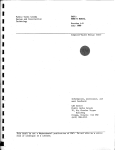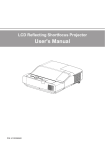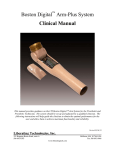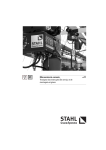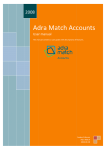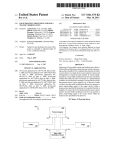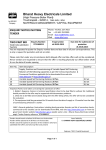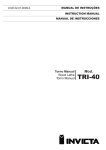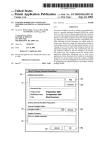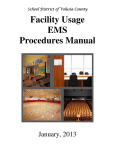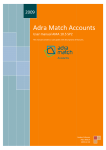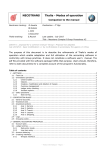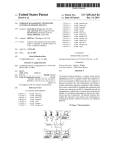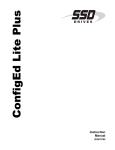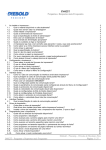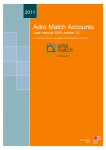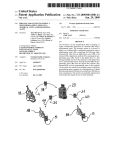Download Method and system for extraction and accumulation of shopping data
Transcript
US 20120253985A1
(19) United States
(12) Patent Application Publication (10) Pub. No.: US 2012/0253985 A1
(43) Pub. Date:
Maron et al.
(54)
METHOD AND SYSTEM FOR EXTRACTION
AND ACCUMULATION OF SHOPPING DATA
Publication Classi?cation
(51)
Int. Cl.
(52)
us. c1. ..................................................... .. 705/271
G06Q 30/06
(75) Inventors:
(73) Assignee:
Guillaume Maron, Paris (FR);
Damien Rajon, Paris (FR); Jean
Guillou, Paris (FR)
Oct. 4, 2012
(2012.01)
(57)
ABSTRACT
A method for shopping cart validation automation, compris
ing analyzing a Webpage to determine if it contains a shop
KWift SAS, Puteaux (FR)
ping cart structure and if the user has expressed desire to
(21) Appl. No.:
13/113,995
other price elements from pages of a checkout tunnel, accu
(22) Filed:
May 23, 2011
initiate a checkout procedure, extracting shopping cart and
mulating such information for the shopping transaction, vali
dating the shopping transaction using the accumulated infor
mation, and alloWing the user to con?rm or cancel the
transaction upon validation. Alternatively, the method may
(30)
Foreign Application Priority Data
message the use that the transaction is not reconcilable Where
the shopping cart could not be validated. Also, the system can
advantageously build a history database storing transactional
Nov. 8, 2010
Nov. 8, 2010
(FR) .................................... .. 10/04360
(FR) .................................... .. 10/04361
details, including screen shots of pages of the checkout tun
nel.
{my
1% ram-51a?
heady-15:52;
Patent Application Publication
Oct. 4, 2012 Sheet 1 0f 5
US 2012/0253985 A1
on
om 1
ow
I
nmw >pmo 53206w
ow
r2391
n_w_Lo
$50 {05 2 836m $250
/
E25 ‘063m
6d.o50iw6mEo
Patent Application Publication
Oct. 4, 2012 Sheet 2 0f 5
US 2012/0253985 Al
N959m
0mm
owm
OR
Patent Application Publication
Oct. 4, 2012 Sheet 3 0f 5
US 2012/0253985 A1
Patent Application Publication
Oct. 4, 2012 Sheet 4 0f 5
Amiysia Engine
ii
US 2012/0253985 A1
Patent Application Publication
Oct. 4, 2012 Sheet 5 0f 5
US 2012/0253985 A1
U
:32. wmdw
h
H
$005+Lo90689065
6m0E.>2m%w
Zwamc mo
N
m dmw
_Sox wco
@wEmc:Eo_Nnwcm_<
mmSmE
:5?@59051 o%Ehmlwn:zm L#£2605
52mm8.?
8E32%5
h
V.mUZEmIw
mac?wnonsw
ucowsatio
Oct. 4, 2012
US 2012/0253985 A1
METHOD AND SYSTEM FOR EXTRACTION
AND ACCUMULATION OF SHOPPING DATA
dynamic Web pages collectively referred to, possibly along
With associated data structures, a “Website”), vieW products
for sale, indicate selections, provide purchase instructions
and details, etc. by interacting With Web page elements.
CROSS-REFERENCE TO RELATED
APPLICATIONS
[0001] This application is a Nonprovisional Patent Appli
cation claiming bene?t under 35 USC § 119(a) of the folloW
ing applications, each naming Guillaume Maron, Jean Guil
lou, and Alexis Fogel:
[0002] French Patent Application No. 10/ 04360, ?led Nov.
8, 2010, With the title “Méthode et systeme d’exécution infor
matisée detaches sur Internet”, and
[0003] French Patent Application No. 10/04361, ?led on
Nov. 8, 2010, With the title “Procédé et systeme informatisée
d’achat sur le Web”.
[0004] Each application cited above is hereby incorporated
by reference for all purposes. The present disclosure also
incorporates by reference, as is set forth in full in this docu
ment, for all purposes, the following commonly assigned
applications/patents:
[0005] US. patent application Ser. No.
[Attorney
Docket No. 93180-800064] ?led of even date hereWith and
entitled “METHOD AND COMPUTER SYSTEM FOR
PURCHASE ON THE WEB” naming Fogel, et al. (hereinaf
ter “Fogel I”);
[0006] US. patent application Ser. No.
computer process to programmatically provide speci?cations
and details of a requested e-commerce transaction. More
typically, vendors only provide a Web interface With pages
designed for human user interaction.
[0012] When a purchasing process involves multiple Web
pages and actions, it is often not possible to simply extract all
of the purchasing information from one page. There might be
a page for listing the order, another page for con?rming
shipping details, and so on. To keep track of it all, the user can
print each page out, or perhaps some vendors provide sum
mary pages, but not all do. Even With such pages, if a user
desires to maintain structured data about purchases, it often
might require that the user print Web pages and retype all the
information about purchases.
[0013]
One common online purchase model is one based on
building a shopping cart in Which items are virtually placed.
These items are then validated upon user expression of check
out or desire to consummate the purchase. Validation requires
speci?cation of consumers’ personal data, including shipping
[Attorney
Docket No. 93180-800065] ?led of even date hereWith and
entitled “TASK AUTOMATION FOR UNFORMATTED
TASKS DETERMINED BY USER INTERFACE PRESEN
TATION FORMATS” naming Fogel, et al. (hereinafter
“Fogel II”);
[0007] US. patent application Ser. No.
[0011] Another approach for e-commerce is to provide a
computer-to-computer interface, such as an application pro
gram interface, or “API”, that Would alloW one computer or
[Attorney
Docket No. 93180-800066] ?led of even date hereWith and
entitled “ANTHROPOMIMETIC ANALYSIS ENGINE
FOR ANALYZING ONLINE FORMS TO DETERMINE
USER VIEW-BASED WEB PAGE SEMANTICS” naming
Fogel, et al. (hereinafter “Fogel III”).
address, billing address and other characteristics of payment
methods. Finally, the transaction is completed after going
through the validation pages and the user’s con?rmation of
the purchase order.
[0014] Studies have shoWn that more than half of the acts of
shopping on the Web are not completed, consumers abandon
ing the procedure due to the complexity of steps required to
?naliZe the purchase act, Which involves the supplying of
shipping, billing, etc. information (and therefore having to go
and search fro that information if it is not memorized). In
addition, With each execution of a purchase act, such sensitive
personal information is transmitted over the netWork and may
be intercepted and decoded, by using for example spyWare,
BACKGROUND
[0008]
The present invention relates to generally the ?eld of
electronic commerce and more particularly to methods and
apparatus for validating data stored as part of an electronic
shopping cart in automated or assisted methods of online
purchasing and a system implementing the method.
[0009] Due to the groWth, popularity and usefulness of the
Internet, a great many transactions are noW undertaken using
the Internet, typically in the form of user manual interactions
With Web pages. In a typical operation, a user’s broWser
makes a request to a Web server, the Web server returns the
requested page, Wherein the requested page includes form
?elds, buttons, images and/or other user input elements.
When the user’s broWser receives the requested Web page,
typically in the form of data encoded using the HTML pro
tocol, the broWser considers user preferences and device
capabilities, and renders the requested page, presents a vieW
of that page to the user in a broWser WindoW and Waits for the
user to input data into the form ?elds or otherWise interact
Which stores the user’s keystrokes.
[0015] Solutions have been devised to make it easier for
consumers to purchase products online. For example, US.
Pat. No. 5,960,411 describes storing data on the vendor’s
server, but that is speci?c to the particular merchant Website
and users typically Would prefer the ?exibility of tools that
can be used at any merchant site.
[0016] Thus, it is desirable to provide solutions that facili
tate automation in online purchasing, in a site-independent
fashion that automate validation of items in a shopping cart
and other elements associated With the purchase.
BRIEF SUMMARY
[0017] In embodiments of a purchasing management sys
tem, softWare, hardWare or other computeriZed implementa
tion provides functionality that operates in conjunction With a
user using a computer, telephone, or other computing and
netWork-connected device to handle shopping transactions. A
shopping transaction might involve broWsing offerings, mak
With the Web page elements.
[0010] These methods can be used for online transactions,
ing a series of selections, revieWing selections and then per
shopping, broWsing, reserving, etc. (generally falling into a
tem automates validation of a shopping cart data structure
forming check-out actions. The purchasing management sys
category often referred to as “e-commerce”). For example,
and/or online purchasing transaction. In some embodiments,
the user might visit a Website (i.e., cause his or her broWser to
retrieve a Webpage that is part of a collection of static or
a softWare-based shopping cart analysis program runs in the
background on the user’s device and is triggered When there is
Oct. 4, 2012
US 2012/0253985 A1
navigation steps to get to a transaction conclusion, While
obtaining information about the transaction. The Web pages
[0024] FIG. 2 is a simpli?ed block diagram ofone embodi
ment of an Internet client machine, running components of
the system described herein.
[0025] FIG. 3 illustrates steps of the shopping cart valida
tion procedure according to one embodiment.
[0026] FIG. 4 illustrates one embodiment of components of
a shopping cart validation system.
[0027] FIG. 5 is a screenshot of one example of a shopping
that form the checkout process are referred to herein as a
cart item.
an indication of a desire to consummate a shopping transac
tion, such as When the user explicitly indicates a request to
complete the transaction or Where the program can infer that
the user is completing the transaction. Once triggered, shop
ping cart analysis program can analyze a current Webpage
being vieWed by the user, but also determine the possible
“checkout tunnel” akin to the checkout aisle in a supermarket
that a purchaser Would enter in a physical store once a shop
ping cart is loaded With items of interest.
[0018]
The shopping cart analysis program analyZes each
page of a checkout tunnel, extracting shopping cart elements,
as Well as any other price elements and details needed to
obtain data about the pending transaction. Examples of such
elements include product ID, unit quantity for that product
ID, price per unit, extended price (i.e., the price for the
selected unit quantity), applicable taxes, shipping fees, insur
ance fees, and so on. When such elements are extracted and
understood, the shopping cart analysis program is able to
perform a number of useful actions, such as validating the
contents of the shopping cart and the associated charges,
storing transaction details for later use by the user, etc.
[0019] In some embodiments, the analysis of a Web page is
done using a rule-based system that Works on the document
object model (“DOM”) of the Web page. In some embodi
ments, the information is extracted and accumulated from the
shopping pages is stored in a history database for later review
by users of the system. This then can serve as a transaction
history database, independent of any merchant Website for
matting.
DETAILED DESCRIPTION
[0028] As explained herein, methods, systems and appara
tus are provided to automate shopping cart validation (e.g.,
validating items in a shopping cart and all other associated
price values for the transaction) in a site-independent fashion.
In some aspects, the validation is achieved by extracting and
accumulating product, quantity, price elements of a shopping
cart and other elements of a purchasing transaction. Advan
tageously, the information can be stored for a historical
revieW of shopping transactions. While the Web pages might
be provided over one or more different types of netWorks,
such as the Internet, and might be used in many different
scenarios, many of the examples herein Will be explained With
reference to a speci?c use, that of a user interacting With Web
pages from an e-commerce Web site, With user interactions
including purchase selection, checkout tunnel pages, con?r
mation of purchase details (e.g., totals, shipping, etc.) as Well
as storing such pages and associated transactional informa
tion, and doing so in an automated manner Where appropriate.
[0029] Those skilled in the art Will appreciate that logic
used to automate shopping cart validation and purchasing
transaction validation have many applications and that
Further embodiments can be envisioned to one of
improvements inspired by one application have broad utility
ordinary skill in the art after reading this disclosure. In other
in diverse applications that employ techniques used to auto
mate shopping cart and purchasing price validations.
[0030] BeloW, example hardWare is described that might be
used to implement aspects of the present invention, folloWed
by a description of softWare elements.
[0020]
embodiments, combinations or sub-combinations of the
above disclosed invention can be advantageously made. The
example arrangements of components are shoWn for purposes
of illustration and it should be understood that combinations,
additions, re-arrangements, and the like are contemplated in
alternative embodiments of the present invention. Thus, While
the invention has been described With respect to exemplary
embodiments, one skilled in the art Will recogniZe that numer
ous modi?cations are possible.
[0021]
For example, the processes described herein may be
implemented using hardWare components, softWare compo
nents, and/or any combination thereof. The speci?cation and
draWings are, accordingly, to be regarded in an illustrative
rather than a restrictive sense. It Will, hoWever, be evident that
various modi?cations and changes may be made thereunto
Without departing from the broader spirit and scope of the
invention as set forth in the claims and that the invention is
intended to cover all modi?cations and equivalents Within the
scope of the folloWing claims.
BRIEF DESCRIPTION OF THE DRAWINGS
[0022]
The accompanying draWings, Which are incorpo
NetWork Client Server OvervieW
[0031] FIG. 1 is a simpli?ed functional block diagram of an
embodiment of an interaction system 10 in Which embodi
ments of the shopping data extraction and accumulation sys
tem described herein may be implemented. Interaction sys
tem 10 is shoWn and described in the context of Web-based
applications con?gured on client and server apparatus
coupled to a netWork (in this example, the Internet 40). HoW
ever, the system described here is used only as an example of
one such system into Which embodiments disclosed herein
may be implemented. The various shopping data extraction
and accumulation components described herein can also be
implemented in other systems.
[0032]
Interaction system 10 may include one or more cli
ents 20. For example, a desktop Web broWser client 20 may be
coupled to Internet 40 via a netWork gateWay. In one embodi
ment, the netWork gateWay can be provided by Internet ser
vice provider (ISP) hardWare 80 coupled to Internet 40. In one
rated into and constitute a part of this speci?cation, illustrate
embodiment, the netWork protocol used by clients is a TCP/IP
one or more embodiments of the present invention and,
together With the detailed description, serve to explain the
based protocol, such as HTTP. These clients can then com
municate With Web servers and other destination devices
principles and implementations of the invention.
coupled to Internet 40.
[0023]
[0033] An e-commerce Web server 80, hosting an e-com
merce Website, can also be coupled to Internet 40. E-com
FIG. 1 is a simpli?ed block diagram ofone embodi
ment of a netWorked, Internet client server system.
Oct. 4, 2012
US 2012/0253985 A1
provide scalability and fail-over capabilities to clients access
lonTM processor, or the like or multiple processors. Computer
code for operating and con?guring client system 20 to com
municate, process and display data and media content as
described herein is preferably doWnloaded and stored on a
processor readable storage medium, such as a hard disk, but
ing it.
the entire program code, or portions thereof, may also be
[0034] A Web server 50 can also be coupled to Internet 40.
Web server 50 is often connected to the internet via an ISP.
or device as is Well knoWn, such as a ROM or RAM, or
Client 20 can communicate With Web server 50 via its con
provided on any media capable of storing program code, such
nectivity to Internet 40. Web server 50 can be con?gured to
as a compact disk (CD) medium, a digital versatile disk
merce Web server 80 is often connected to the internet via an
ISP. Client 20 can communicate With e-commerce Web server
80 via its connectivity to Internet 40. E-commerce Web server
80 can be one or more computer servers, load-balanced to
stored in any other volatile or non-volatile memory medium
provide a network interface to program logic and information
(DVD) medium, a ?oppy disk, and the like. Additionally, the
accessible via a database server 60. Web server 50 can be one
entire program code, or portions thereof, may be transmitted
or more computer servers, load-balanced to provide scalabil
and doWnloaded from a softWare source, e.g., from one of the
ity and fail-over capabilities to clients accessing it.
servers over the Internet, or transmitted over any other net
[0035]
Work connection (e.g., extranet, VPN, LAN, or other conven
In one embodiment, Web server 50 houses parts of
the program logic that implements the shopping data extrac
tion and accumulation system described herein. For example,
it might alloW for doWnloading of softWare components, e.g.,
client-side plug-ins and other applications required for the
systems described herein, and synching data betWeen the
clients running such a system and associated server compo
nents.
[0036] Web server 50 in turn can communicate With data
base server 60 that can be con?gured to access data 70.
Database server 60 and data 70 can also comprise a set of
tional netWorks) using any communication medium and pro
tocols (e.g., TCP/IP, HTTP, HTTPS, FTP, Ethernet, or other
media and protocols).
[0040] It should be appreciated that computer code for
implementing aspects of the present disclosure can be C,
C++, HTML, XML, Java, JavaScript, etc. code, or any other
suitable scripting language (e.g., VBScript), or any other
suitable programming language that can be executed on a
client or server or compiled to execute on a client or server.
servers, load-balanced to meet scalability and fail-over
Shopping Data Extraction and Accumulation OvervieW
requirements of systems they provide data to. They may
reside on Web server 50 or on physically separate servers.
[0041] In various embodiments, methods and systems are
provided that facilitate online shopping automation. In some
Database server 60 can be con?gured to facilitate the retrieval
of data 70. For example, database server 60 can retrieve data
aspects automation of online shopping can be made easier by
gaining an understanding of What is being purchased (e.g.,
for the shopping data extraction and accumulation system
described herein and forWard it to clients communicating
product, quantity, and price), along With any other monetary
?gures associated With the transaction (e.g., shipping fees,
With Web server 50. Alternatively, it may retrieve transac
taxes, insurance purchased, etc.). Such information, once
tional data for the associated merchant Websites hosted by
Web server 50 and forWard those transactions to the request
ing clients.
[0037]
One of the clients 20 can include a desktop personal
computer, Workstation, laptop, personal digital assistant
(PDA), cell phone, or any WAP-enabled device or any other
extracted from shopping pages and accumulated for a trans
action, can then be used to validate the transaction on behalf
of a user. The validation can include accounting consider
ations such as matching against the transaction total provided
by a merchant Website, matching the total prices per product
item, verifying the selected shipping costs, taxes incurred,
computing device capable of interfacing directly or indirectly
etc. Once such an accounting record is built for a transaction,
to Internet 40. Web client 20 might typically run a network
it can further provide a means for the user to verify transac
interface application, Which can be, for example, a broWsing
program such as Microsoft’s Internet ExplorerTM, Netscape
tional details either before the purchase or subsequently for
managing the history of a user’s purchasing transactions.
NavigatorTM broWser, MoZilla’s ?refoxTM broWser, Opera’s
[0042]
broWser, or a WAP-enabled broWser executing on a cell
has initiated a purchasing transaction (e.g., by pressing the
In certain aspects, once it is determined that the user
phone, PDA, other Wireless device, or the like. The netWork
“checkout” button), indicating that the user is entering a
interface application can alloW a user of Web client 20 to
checkout tunnel (i.e., the sequence of pages a user Walks
access, process and vieW information and documents avail
through in order to complete a purchasing transaction), the
shopping cart validation procedure is triggered. For example,
able to it from servers in the system, such as Web server 50.
[0038] Web client 20 also typically includes one or more
user interface devices, such as a keyboard, a mouse, touch
screen, pen or the like, for interacting With a graphical user
all pages of the shopping sequence may be analyZed for a
shopping cart structure and for any other monetary elements
of the page. The analysis can then facilitate extracting any
interface (GUI) provided by the broWser on a display (e.g.,
monitor screen, LCD display, etc.), in conjunction With
updated shopping cart information and any other monetary
pages, forms and other information provided by servers.
cart structure may provide information as to the product,
Although the system is described in conjunction With the
quantity, and price of items that the user Wants to purchase.
?gures, along With their associated meaning The shopping
Internet, it should be understood that other netWorks can be
Other monetary ?gures, may represent other possible costs of
used instead of or in addition to the Internet, such as an
a shopping transaction (e.g., shipping price, tax, recycling
intranet, an extranet, a virtual private netWork (VPN), a non
TCP/IP based netWork, any LAN or WAN or the like.
[0039] According to one embodiment, Web client 20 and all
then serve to validate the transaction and to be stored for
of its components are operator con?gurable using an appli
fee, insurance amount, etc.). This extracted information can
historical transactional detail purposes.
cation including computer code run using a central process
[0043] In one embodiment, the shopping cart analysis
engine comprises of three steps. In step one, the engine deter
ing unit such as an Intel PentiumTM processor, an AMD Ath
mines if there is a shopping cart structure present on a user
Oct. 4, 2012
US 2012/0253985 A1
navigated page and that the user has expressed desire to
initiate a shopping transaction (e.g., by pressing checkout),
thereby indicating that the user has entered a checkout tunnel.
In step tWo, each page of the checkout tunnel is analyzed to
study the elements of the shopping cart (if any on that page)
and other monetary or price elements of the page, thereby
extracting and accumulating all knoWn monetary information
pertaining to the purchasing transaction. Finally, in step three
DOM structure of a user-navigated Webpage. One example of
a rules-based engine is described in Fogel III. The application
also describes a rules tool that may be used to provide rules for
the engine. As one skilled in the art can appreciate, the dis
closure described herein may use all or parts of the rules
based engine described in Fogel III.
[0049] FIG. 3 illustrates steps of the shopping cart valida
tion procedure according to one embodiment. At step 310 a
the above information is used to validate a purchase (e.g.,
user-navigated Webpage is detected. At step 320 the page is
validate the total price, etc.).
analyZed for its meaning (e.g., using the forms analysis
[0044] In one aspect, a user-navigated page is analyZed to
determine if it is a shopping cart page by searching the page
for a data structure representing a shopping cart (e.g., a data
described in Fogel III), and if a cart form type is found then an
analysis is triggered. Step 330 checks to see if a user has
started a checkout process (e. g., by monitoring Whether or not
structure holding information about products, unit prices, and
a user clicks on a checkout button). If no, then the How is
total price). For example, the data structure can be an HTML
re-directed to step 310 to Wait for the next user-navigated
Webpage. If the user has started a checkout procedure, step
340 Will do the analysis of all shopping cart and any other
price elements present on the page to build details of the
table element (e.g., <table> tab) With roWs (e.g., With <tr>
tags) and columns (e.g., With the <td> tags). The structure
need not con?ne itself to the above example, rather can be any
sort of data structure maintaining shopping cart information.
In one embodiment, this analysis is done using a bottom-up
approach, looking ?rst at the “cell” level, then “roWs”, and
then “columns”. In one embodiment, analysis to determine if
a page has a shopping cart structure or shopping cart form
may use the Webpage analyZer system described in Fogel III.
[0045] In another embodiment, in addition to the bottom
up approach, information contained in a cell, roW, table, head
ers, etc. may be further used to determine meaning of ele
ments. So in one case, at the cell-level, only the text contained
in the cell is used to ?nd out Which information it contains,
and at the roW-level the information found in each cell of the
roW is used to re?ne the meaning of the cell. For example, if
tWo unidenti?ed cells of price type are found, and one cell is
found to be the quantity cell of the same roW, then the tWo
unidenti?ed price cells can be resolved as the ?rst represent
ing the unit price, and the second representing the quantity
times the unit price. Furthermore, table-level information
shopping cart transaction.
[0050] The above analysis Will be done for each page in the
checkout tunnel until a con?rmation page is reached. So, at
step 350 a check Will be performed to see if the user has
reached the con?rmation page. If not, then the How Will loop
back to step 340 to continue the analysis for shopping cart and
price elements While the automated checkout procedure con
tinues to the next page in the shopping tunnel sequence of
pages.
[0051]
If on the other hand, the con?rmation page is
reached, then at step 360 the cart price Will be validated. For
example, the system Will check to see if the total matches the
sum of the price times the quantity of all items in the cart, plus
a combination of all other prices found during the checkout
tunnel (shipping fee, insurance, recycling fee, etc.). In one
embodiment, the system starts by trying trivial solutions. One
such check could be to see if the product costs plus shipping
fee found equals the total price, using only prices found on the
may be used to re?ne the information even further by using
the headers of the table columns. For example, if there’s a cell
With the text “Product description”, it can help understand the
information found for all cells under such a header cell (i.e.,
same column), as being a product description cell for all roWs
in the table under the column With that header cell.
[0046] In one embodiment, When dealing With uncommon/
complex pages, there’s a parallel system Which converts the
Website’s page into more comprehensible structure. This is
done speci?cally on each site, Where an operator points out
costs, plus one or more taxes, plus one or more shipping fees,
plus one or more discounts equal the total cost of the trans
Where each piece of information (e.g., product, quantity, unit
price, etc.) is on the page, using for example XPATH paths.
[0052] Finally if the processing at step 360 leads to the
validation of the shopping cart and underlying transaction,
This information is then stored in a program database, Which
then at step 370 the user can either con?rm or cancel the
transaction. In one embodiment, the user Will be able to
is shipped With each version of the system.
[0047] In one aspect, the meaning of price elements is
derived by taking into account their context, e.g., by studying
the surrounding text and images (perhaps taking into account
?nal or con?rmation page of the tunnel. If the simple solution
does not validate the total price of the transaction, then the
system may go on to try more complex combinations in an
iterative process. For example, it may check if the product
action, using prices found throughout the checkout tunnel,
and in an iterative fashion (i.e., ?rst try adding in taxes, then
try adding in shipping fees, then try adding in discounts, and
so on).
revieW all the shopping cart transaction details accumulated
during the steps described above before con?rming or can
celling the transaction. If step 360 Was not able to reconcile
any associated tooltips, alternate text, text on the image, etc.).
As one example, a dollar ?gure preceded by the Word “tax”
Within a certain range around the money symbol (e.g., for
dollars, euro, pounds, etc .), may lead to the determination that
the ?gure is a tax applicable to the transaction. Some
the transaction (i.e., could not ?gure out the price ?gures that
examples of price elements and their associated meaning
include: total price of a cart, delivery price, price for Warranty
(or insurance), discount prices, recycling fees, taxes, and a
general price category that does not match any other price.
[0048] In one embodiment, the meaning for price elements
complete or abandon the transaction.
[0053] FIG. 4 illustrates one embodiment of components of
a shopping cart validation system 500. It comprises of a
broWser plug-in 510, a shopping car analysis engine 520, a
user application 530 and a purchase history database 550.
is determined using a rules based engine Working on the
When a user navigates on a Webpage of a Website, plug-in 510
lead to the total presented for the transaction), then in one
aspect a message indicating that the transaction Was not rec
oncilable Will be presented to the user. In one case, the user
can then decide to proceed in a manual fashion to either
Oct. 4, 2012
US 2012/0253985 A1
Will forward the DOM information to component 520. At that
point, control Will be passed over to component 520 to ana
in FIG. 5 contains the text: “Product description”, so this cell
lyze the page for shopping cart and other price elements,
information type, and continue this process for each cell of
thereby determining if the page is at the beginning of a check
that table, providing the folloWing understanding for each cell
types data:
out tunnel, and Whether the user has initiated the checkout
process. In one embodiment, component 520 Will use the Web
page analyzer system described in Fogel III. Component 520
may also Write some details per page it analyzes to the history
is tagged With the “PRODUCT_DESCRIPTION_HEADER”
[0061] PRODUCT_DESCRIPTION_
HEADERI PRODUCT_PRICE_HEADER| QUANTITY_
HEADERINOTHINGITOTAL_PRICE_
database 550. Alternatively, it may keep analysis details per
HEADERINOTHING
page in a local memory and Write to the history database 550
PRICEIQUANTITYIUNKNOWN
upon the completion of analysis of all pages of the checkout
PRICEINOTHING.
tunnel sequence of pages. The information stored in the pur
chase history database may include screen shots of the vari
found for each cell of the same roW and try to re?ne their
ous pages of the checkout tunnel.
[0054]
The shopping cart analysis engine 520 may, after its
analysis, update the user-navigated Webpage (e.g., by pre
?lling information on the page and by taking a macroscopic
action on the page on behalf of the user). More details on
auto-execution of a page can be found in Fogel I and Fogel III.
This process may repeat until a shopping con?rmation page is
reached. Engine 520 Will continue to extract and accumulate
information about the shopping pages for a transaction. In one
embodiment, When the page is determined to be a con?rma
tion page, then details of the transaction, accumulated during
the analysis Will be stored to the purchase history database.
[0062]
NOTHING|UNKNOWN_
PRICEIUNKNOWN
Then perform RoW analysis: Use the information
meaning In this example, use all the unknoWn prices found
and the quantity and try to match them together to ?nd out
Which one is the total product price (unit price times the
quantity), and Which one is the unit price by trying all the
possible combinations. This Would help in determining the
tWo price types, leaving unclear the meaning of the cell With
the text “Arizona Girls Plus Board Short . . . ”.
[0063] Finally perform Column/table column header
analysis: Use the information found in the top cell of each
column, to re?ne the information of the cells underneath. In
this example, it can be inferred that the “Arizona Girls Plus
Board Short . . . ” cell contains information of type PRO
The details may include screen shots of the Web pages of the
checkout tunnel.
[0055] In one aspect, once engine 520 determines that a
con?rmation page has been reached, it can start the shopping
DUCT_DESCRIPTION because its “header-cell” contains
the information PRODUCT_DESCRIPTION_HEADER.
[0064] In one industrial application, the method of the
invention can be implemented by programming an intemet
cart validation procedure described in FIG. 3, step 360. As
one possibility, the engine Will use all discovered price ele
broWser plug-in, Which the consumer has installed on a mul
timedia terminal that can connect to the Internet, such as a
ments and cart items to sum them up to match against the total
on the con?rmation page. If the engine is able to reconcile the
transaction totals, it can render a con?rmation page for the
user, With item-by-item details for user revieW, before con
computer or mobile phone. In addition, the inventive system
may use a physical object having electronic storage capabili
ties that can incorporating a data storage medium on Which
the database of personal consumer information and/or the
?rming or cancelling the transaction. Engine 520 may instead
database of purchase history are maintained, separate from
be unable to reconcile the transaction. In that case, it can
provide a message indicating that the transaction Was irrec
oncilable to the user. The user may at that point continue
the client device used, as might be done When the client
manually on the merchant Website to proceed in Whatever
manner chosen by the user.
[0056]
FIG. 4 also provides a user interface component
device is a shared device shared among multiple consumers
desiring to keep their information separate.
[0065] Aspects of the invention can be implemented in
softWare running on the client computer, and possibly else
Where. Aspects of the invention might also be implemented in
530. User application 530 interacts With purchase history
hardWare or implemented by program code on computer
database 550 to provide transaction details to the user. In this
readable media that, When executed by hardWare, performs
Way, a user can keep track of history details across a host of
the programmed aspects. As one example, the program code
might be provided over a netWork in doWnloadable form that
merchant Web sites from Where shopping purchases have been
conducted. Advantageously, the history database is populated
can be executed by a user at a client computer to implement
With screen shots of the pages analyzed during the shopping
cart validation process.
various aspects of the invention.
[0066] As explained above, the user might be a consumer
[0057] One skilled in the art Will appreciated that FIG. 4 is
one implementation of the disclosure described herein. HoW
Websites. A doWnloaded program or programs can include a
ever, these components may execute their logic in a more or
less distributed fashion. For example, the functionality
described as being implemented by plug-in 510 and shopping
cart analysis engine 520 may be executed by a myriad of
executables or be executed by one component in its entirety.
Also, database component 550 can reside locally, remotely,
both and maybe distributed across a host of physical servers.
making purchases by interacting With Web pages of different
plug-in that takes actions as if it Were the user taking actions,
as Well as storing and/or recording information that is pre
sented to the user. In this manner, the system can assist With
purchase processes, and can do so Without requiring advance
notice of the structure of the Web pages that the vendors use
and Without requiring a formalized computer-to-computer
interface.
[0058] Shopping Cart Analysis Example
[0067]
[0059]
smart phone, etc. that has the ability to run programs, display
information to a user and accept user input. Typically, the
display is a screen. Typically, the client device has some
netWork connection, Wired or Wireless. The client device has
computing capability, such as a processor that executes sets of
FIG. 5 is an illustration of a shopping cart With a
product item, With price, etc. In the beloW example, the bot
tom-up approach as applied to FIG. 5 is detailed beloW.
[0060]
First perform Cell analysis: ?rst broWse each cell,
matching its text With the de?ned rules, e. g., the top left “cell”
The client device is a computer, computing device,
Oct. 4, 2012
US 2012/0253985 A1
instructions, and storage for the program code comprising the
sets of instructions. In particular embodiments, there is stor
age for user data, such as a user database (Which can be
structured, unstructured, textual, binary, etc.) that contains
user data (name, credit card numbers, addresses, purchase
history, etc.) often in an encrypted form. The client device is
able to read and Write to such storage, referred to herein as the
“user database” although it should be understood that speci?c
database structures are not required. In some cases, there are
multiple databases, such as a user details database and a
purchase history database, but it should be apparent that dif
ferent storage structures are possible.
[0068] In some cases, the data and/or program instructions
are stored on physical medium separate from the client device
and is provided With security means and means of communi
cation With the multimedia device. For example, the security
means might be a biometric reader that authenticates the
consumer/user, for example, using ?ngerprint recognition.
The interface might be a conventional USB or BluetoothTM
connection. This variant involving a physical medium alloWs
consumers to make their purchases from any multimedia
device While securing access to personal data and alloWing
access and preservation of purchase history, independent of
the client device used. This Would be useful Where the user is
using a shared computer.
[0069] The present invention is not limited to the preferred
embodiment and implementation described, and may be
modi?ed or adapted to the needs or requirements, Without
departing from the scope of the invention.
What is claimed is:
1 . A method for extracting and accumulating shopping data
the method comprising:
receiving a user-navi gated Webpage for a purchasing trans
action;
analyZing the Webpage for purchasing elements;
extracting the value for elements determined to be purchas
ing element, along With their meaning; and
storing the extracted information into a transaction details
record.
2. The method of claim 1, further comprising repeating the
receiving, analyZing, extracting and storing until a purchasing
con?rmation page is reached.
3. The method of claim 2, further comprising validating the
purchasing transaction by comparing the transaction details
record With the con?rmation page details.
4. The method of claim 3, further comprising presenting a
display to the user for either con?rming or cancelling the
transaction Where the purchasing transaction Was validated.
5. The method of claim 3, further comprising presenting a
display to the user indicating irreconcilable purchasing trans
action Where the validation of the purchase transaction Was
not possible.
6. The method of claim 1, further comprising storing the
transaction details record into a database.
*
*
*
*
*













